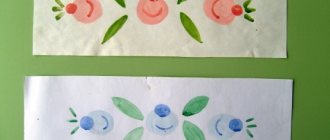Set of educational cards “Dymkovo Fairy Tale”.
Set of educational cards “Dymkovo Tale”
Rugacheva Olesya Vladimirovna,
teacher of the highest qualification category
Explanatory note
Educational area:
artistic and aesthetic development (visual activity).
Topics reflected in the cards:
elements of Dymkovo painting; color variety of painting elements; the difference between Dymkovo painting and Gorodets painting; material necessary for making the Dymkovo toy; elements of Khokhloma, Gorodets and Zhostovo ornaments.
Age:
children 5-7 years old (senior preschool age).
Type of lesson:
studying, consolidating and systematizing the material.
Child knowledge and skills required for work:
knowledge of the history of the Dymkovo toy; the ability to name the species diversity of toys; knowledge of painting elements; the ability to distinguish Dymkovo painting from Gorodets, Khokhloma and Zhostovo; ability to compare, analyze and reason.
Expected results:
consolidation and systematization of knowledge about Dymkovo painting; developing the ability to distinguish it from other types of painting; developing the ability to create your own ornament when working with a Dymkovo toy, selecting appropriate colors and elements.
Material:
laminated cards measuring 11*16 cm (10 pieces), a damp cloth, felt-tip pens of different colors.
Instructions for using cards
1. “Which toy is the odd one out? Why?"
Goal: to consolidate the ability to find a Dymkovo toy based on the elements of the painting.
Procedure: invite the children to carefully examine the card and circle the extra toy, explain their decision, name all types of painting (the extra one is a wooden horse in Gorodets painting).
Time allotted for working with the card: 3-4 minutes.
2. “What patterns will we decorate the lady with?”
Goal: to consolidate the ability to select elements of the Dymkovo ornament.
Procedure: invite the children to carefully examine the card and use arrows to connect the lady with the ornamental elements used by the Dymkovo masters. Explain your decision, name all types of painting (Khokhloma, Dymkovo, Gorodets, Zhostovo).
Time allotted for working with the card: 3-4 minutes.
3. “Repeat the pattern”
Goal: to strengthen the ability to draw elements of Dymkovo painting.
Procedure: invite children to carefully examine the elements of the painting and repeat them according to the model.
Time allotted for working with the card: 3-4 minutes.
4. “Find your soulmate”
Goal: to consolidate the ability to find the other half of a toy.
Procedure: invite the children to carefully examine the card and use arrows to connect the halves of the Dymkovo toys.
Time allotted for working with the card: 3-4 minutes.
5. “What color should we paint the toy?”
Goal: to consolidate the ability to select colors for Dymkovo painting.
Procedure: invite the children to carefully examine the card and use an arrow to connect the toy with a geometric figure of the color that the craftsmen used to paint Dymkovo toys (all colors on the card are suitable).
Time allotted for working with the card: 3-4 minutes.
6. “What is the toy made of?”
Goal: to consolidate the ability to find and name the material necessary for making a Dymkovo toy.
Procedure: invite children to carefully examine the card and use an arrow to connect the toy with the material used to make it. Explain your decision, name all types of materials (paper, fabric, clay, woolen threads, wooden boards).
Time allotted for working with the card: 3-4 minutes.
7. “What should we decorate the horse with?”
Goal: to consolidate the ability to select types of Dymkovo painting ornaments that were used to decorate a horse.
Procedure: invite the children to carefully examine the card and use an arrow to connect the toy with the types of ornaments that are used to paint the horse. Explain your decision, name all types of ornaments and their use (the lady’s skirt was decorated with a cage and a wave).
Time allotted for working with the card: 3-4 minutes.
8. “Name the toy”
Goal: to consolidate the ability to recognize and name the main types of Dymkovo toys.
Procedure: invite the children to carefully look at the card and name all the toys (rider, turkey, horse, lamb, water carrier, bird).
Time allotted for working with the card: 3-4 minutes.
9. “Complete the pattern”
Goal: to consolidate the ability to complete the elements of Dymkovo painting.
Procedure: invite children to carefully examine the elements of the painting and complete them according to the model.
Time allotted for working with the card: 3-4 minutes.
10. “Color the pattern”
Goal: to consolidate the ability to paint elements of Dymkovo painting according to plan.
Procedure: invite children to carefully examine the elements of the painting and color them according to plan.
Time allotted for working with the card: 3-4 minutes.
Dymkovo fairy tale DOCX / 2.3 MB
History of the Dymkovo toy
Let us preface the story about the Dymkovo toy with two significant facts:
- it has been made by craftsmen for over 400 years;
- These figures are known and loved not only in our country, but also abroad.
Dymkovo toys (pictures)
The pictures below will help you fully imagine the diversity and beauty of the Dymkovo toy.
The name of the craft was given by the Dymkovo settlement, where these clay figurines began to be made. For a long time this settlement has been part of the city of Kirov, which formerly bore the names Khlynov and Vyatka.
|
The great demand for clay crafts, as well as the presence of large reserves of this natural material, made Dymkovskaya Sloboda the birthplace of the famous folk craft. Of course, the appearance of the first crafts was far from canonical, but over time, the familiar appearance and ornamentation of the Dymkovo toy was formed.
The appearance of the first clay crafts in Dymkovo dates back to the 15th-16th centuries. By this time, the toy loses its sacred meaning, which determined the simplicity of its form: the pagan worldview of the Slavs and pre-Christian rituals are a thing of the past. The shape of the products begins to change, they become beautiful and colorful.
The traditions and manufacturing techniques of the first masters have been preserved to this day. The Dymkovo toy known to us today reflected elements of Russian life of the 19th century; later images of gallant gentlemen and fashionable ladies appeared.
|
Craftswomen of that time not only preserved old traditions, but also brought newness to the appearance of clay crafts, and also came up with new subjects. So craftswoman E.A. Koshkina has achieved great success in creating group compositions. Her work “Sale of Dymkovo Toys” was presented at the international exhibition in Paris in 1937 and received great fame. Craftswoman O.I. Konovalova (daughter of A.A. Mezrina) liked to create images of animals, and craftswoman E.I. Penkina preferred to embody everyday scenes in her compositions.
At the beginning of the Great Patriotic War, the production of figurines practically ceased: the Kirov region was in the rear, and its residents began to work for the front. However, the evacuees really liked the bright crafts, and the craftswomen began creating them again.






